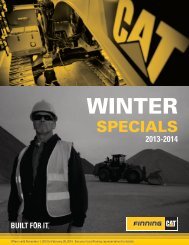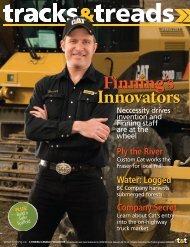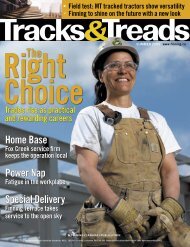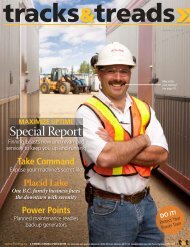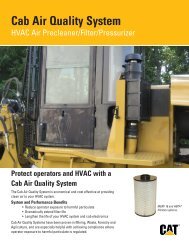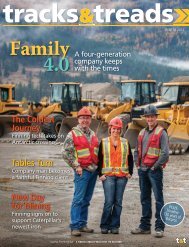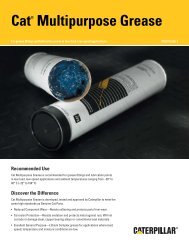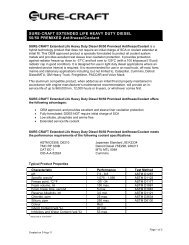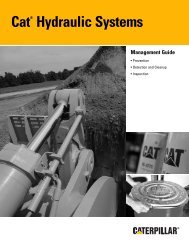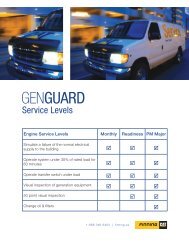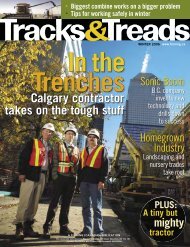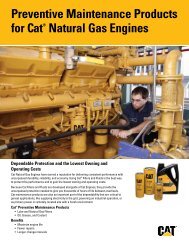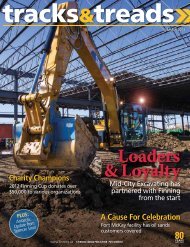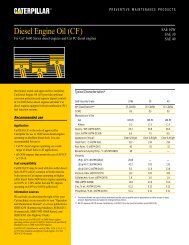Tracks and Treads - Finning Canada
Tracks and Treads - Finning Canada
Tracks and Treads - Finning Canada
Create successful ePaper yourself
Turn your PDF publications into a flip-book with our unique Google optimized e-Paper software.
Safety First<br />
Story by rick overwater<br />
illustration by CHRIS PYLE<br />
A safe construction site starts with a hazard <strong>and</strong> risk<br />
aSSESSment, <strong>and</strong> lies in knowing the difference between the two<br />
Don’t Hazard<br />
a Guess<br />
Zac Brown recalls his early years as a safety<br />
adviser, working for an employer with a<br />
particularly densely populated work zone.<br />
Dump trucks continually moved around<br />
several excavations where a second crew was<br />
laying pipe below. Overhead, a crane lifted<br />
<strong>and</strong> lowered the pipe, with both its boom<br />
<strong>and</strong> counterweight swinging into other work<br />
zones. Amidst all the machinery, men were<br />
on foot everywhere, sometimes out of machinery<br />
operators’ sightlines. Brown knew<br />
that the company needed to increase its emphasis<br />
on safety.<br />
“Often in construction zones, you’re<br />
working pretty close to each other,” says<br />
Brown, “so we did a hazard assessment to<br />
manage the risk at the interface between the<br />
guys hauling waste rock away <strong>and</strong> the guys<br />
installing pipe.” Besides installing fencing to<br />
segregate work areas, the company took an<br />
extra step <strong>and</strong> installed a worker, with a high<br />
visibility vest <strong>and</strong> a radio, to co-ordinate onsite<br />
movement. “That happened because<br />
we sat down <strong>and</strong> did a hazard assessment,”<br />
says Brown, now employed as the director<br />
of Health, Safety <strong>and</strong> Environmental<br />
Protection for Ledcor CMI, a specialist in oilpatch<br />
construction.<br />
Ted Lane is an occupational health <strong>and</strong><br />
safety officer for Alberta Workplace Health<br />
<strong>and</strong> Safety. He points out a compelling reason<br />
for carrying out a hazard assessment at<br />
the start of every job.<br />
“It’s a legal requirement for a start,” he<br />
states matter-of-factly. “The Occupational<br />
Health <strong>and</strong> Safety code requires an employer<br />
to assess a work site <strong>and</strong> identify existing <strong>and</strong><br />
potential hazards. They have to prepare a<br />
report, date it <strong>and</strong> ensure it’s done at reasonable,<br />
practical intervals.” He adds that small<br />
companies are often unaware that this law is<br />
equally applicable to two carpenters building<br />
a deck on a vacation property as it is to<br />
100 workers erecting an office tower.<br />
There are two parts to a hazard assessment.<br />
First, identify the hazard. Second,<br />
identify the risk, <strong>and</strong> make sure you underst<strong>and</strong><br />
the difference between the two.<br />
A hazard is anything that has the potential<br />
to cause harm. “It’s a physical thing,”<br />
Lane explains. “Could it possibly fall on my<br />
head Could it run me over Could it electrocute<br />
me” Risk, on the other h<strong>and</strong>, is the<br />
actual likelihood of being hurt <strong>and</strong> it involves<br />
numerous components. “How badly<br />
is it going to hurt me” he asks. “Is it going to<br />
kill me or give me a paper cut How often is it<br />
likely to kill – several times per shift or twice<br />
a year What’s the likelihood Is it a certainty<br />
or very unlikely”<br />
Answering such questions, Lane continues,<br />
allows you to assess the combination<br />
<strong>and</strong> create a system for implementing controls.<br />
This could be as complex as providing<br />
specialized training <strong>and</strong> protective equipment<br />
to something as simple as making sure<br />
a machine is in good working order, ultimately<br />
yielding a safer workplace.<br />
He cites the example of a factory in which<br />
a large machine with whirling blades has the<br />
potential to kill workers. Meanwhile, outside<br />
there is a chunk missing from the front<br />
step of the building entrance. The blades of<br />
the machine, inside a safety enclosure,<br />
are operated from the<br />
outside <strong>and</strong> the chance of them<br />
contacting workers is minimal.<br />
“It may scare you to death but,<br />
taking the risk into account, you<br />
don’t really have to do anything<br />
about it,” he says. “But the chunk<br />
out of your front step may have<br />
500 people passing over it every<br />
day <strong>and</strong> is much more likely to<br />
hurt somebody than your nasty<br />
machine is.”<br />
Ha zard assessments remain<br />
a key part of Brown’s role,<br />
<strong>and</strong> a Ledcor jobsite generally<br />
sees more than one kind.<br />
Initially, there’s a projectlevel<br />
hazard assessment that<br />
looks at elements affecting the<br />
site, such as weather, overhead power lines<br />
or underground services. On the ground,<br />
generic assessments apply to any jobsite.<br />
“Fixing a pothole is fixing a pothole,” Brown<br />
says. Safety officers carry out assessments at<br />
the start of every task <strong>and</strong> whenever the<br />
project introduces a new element, such as<br />
a change in the machinery or an influx of<br />
new workers.<br />
Regardless of the factors affecting it,<br />
Brown says, one thing is for sure: Day-today<br />
safety starts with a hazard assessment.<br />
“There’s a lot of value in just telling people<br />
‘Hey, wait! Let’s take five <strong>and</strong> think about<br />
what we’re going to do <strong>and</strong> plan how to do<br />
it safely.’”<br />
www.finning.ca Fall 2008 • tracks & treads 33



